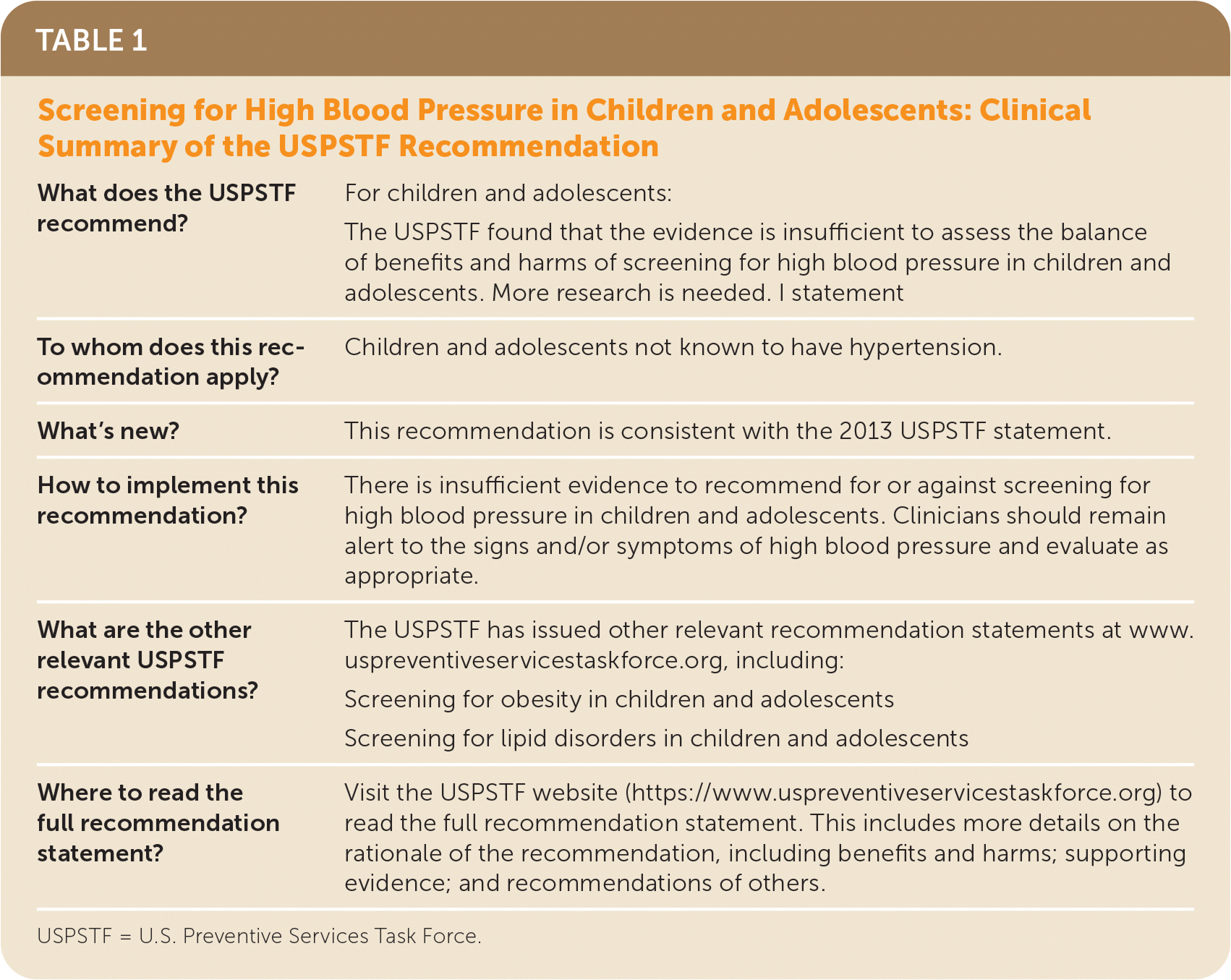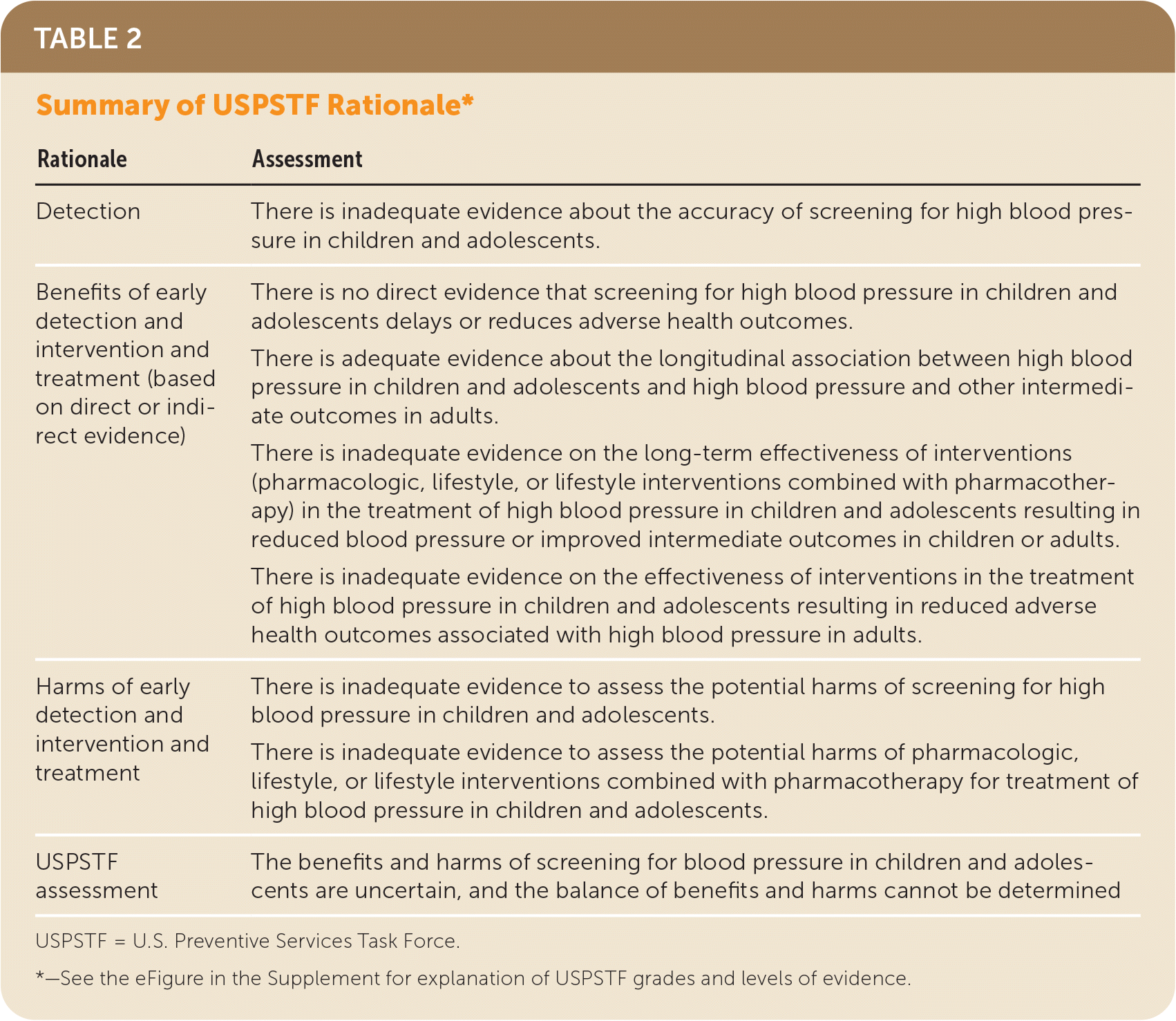
Am Fam Physician. 2021;103(4):online
Related Putting Prevention into Practice: Screening for High Blood Pressure in Children and Adolescents
As published by the USPSTF.
Summary of Recommendation
The USPSTF concludes that the current evidence is insufficient to assess the balance of benefits and harms of screening for high blood pressure in children and adolescents (Table 1). I statement.

| What does the USPSTF recommend? | For children and adolescents: The USPSTF found that the evidence is insufficient to assess the balance of benefits and harms of screening for high blood pressure in children and adolescents. More research is needed. I statement |
|---|---|
| To whom does this recommendation apply? | Children and adolescents not known to have hypertension. |
| What's new? | This recommendation is consistent with the 2013 USPSTF statement. |
| How to implement this recommendation? | There is insufficient evidence to recommend for or against screening for high blood pressure in children and adolescents. Clinicians should remain alert to the signs and/or symptoms of high blood pressure and evaluate as appropriate. |
| What are the other relevant USPSTF recommendations? | The USPSTF has issued other relevant recommendation statements at www.uspreventiveservicestaskforce.org, including: Screening for obesity in children and adolescents Screening for lipid disorders in children and adolescents |
| Where to read the full recommendation statement? | Visit the USPSTF website (https://www.uspreventiveservicestaskforce.org) to read the full recommendation statement. This includes more details on the rationale of the recommendation, including benefits and harms; supporting evidence; and recommendations of others. |
Importance
The prevalence of hypertension (both primary and secondary) in children and adolescents in the United States ranges from 3% to 4% in most studies.1–5 Primary hypertension in children and adolescents occurs primarily in children older than 13 years and has no known cause but is associated with several risk factors, including family history and higher body mass index.1 Secondary hypertension occurs primarily in younger children and is most commonly caused by genetic disorders, renal disease, endocrine disorders, or cardiovascular abnormalities.1,6
USPSTF Assessment of Magnitude of Net Benefit
The USPSTF concludes that the evidence to support screening for high blood pressure in children and adolescents aged 3 to 18 years is insufficient and that the balance of benefits and harms cannot be determined.

| Rationale | Assessment |
|---|---|
| Detection | There is inadequate evidence about the accuracy of screening for high blood pressure in children and adolescents. |
| Benefits of early detection and intervention and treatment (based on direct or indirect evidence) | There is no direct evidence that screening for high blood pressure in children and adolescents delays or reduces adverse health outcomes. There is adequate evidence about the longitudinal association between high blood pressure in children and adolescents and high blood pressure and other intermediate outcomes in adults. There is inadequate evidence on the long-term effectiveness of interventions (pharmacologic, lifestyle, or lifestyle interventions combined with pharmacotherapy) in the treatment of high blood pressure in children and adolescents resulting in reduced blood pressure or improved intermediate outcomes in children or adults. There is inadequate evidence on the effectiveness of interventions in the treatment of high blood pressure in children and adolescents resulting in reduced adverse health outcomes associated with high blood pressure in adults. |
| Harms of early detection and intervention and treatment | There is inadequate evidence to assess the potential harms of screening for high blood pressure in children and adolescents. There is inadequate evidence to assess the potential harms of pharmacologic, lifestyle, or lifestyle interventions combined with pharmacotherapy for treatment of high blood pressure in children and adolescents. |
| USPSTF assessment | The benefits and harms of screening for blood pressure in children and adolescents are uncertain, and the balance of benefits and harms cannot be determined |
Practice Considerations
PATIENT POPULATION UNDER CONSIDERATION
This recommendation applies to children and adolescents not known to have hypertension.
DEFINITIONS OF HYPERTENSION
The American Academy of Pediatrics revised its definitions of abnormal blood pressure in children and adolescents in 2017.8 Hypertension is defined as sustained high blood pressure. Elevated blood pressure (previously known as prehypertension) in children aged 1 to 13 years is defined as 3 auscultatory blood pressure measurements between the 90th and 94th percentile based on age, height, and sex, or 120 to 129/< 80 mm Hg.8 For children aged 1 to 13 years, hypertension is defined as 3 auscultatory blood pressure measurements at 3 different visits that are either equal to or above the 95th percentile based on age, height, and sex, or above 130/80 mm Hg, whichever measurement is lower.1,8 The thresholds for adolescents 13 years or older follow the adult guidelines from the American Heart Association and American College of Cardiology, regardless of sex and height: Stage 1 hypertension is defined as a blood pressure measurement of 130/80 to 139/89 mm Hg, and stage 2 hypertension is defined as a blood pressure measurement above 140/90 mm Hg.1,9
SCREENING TESTS
Best practice is to measure blood pressure by auscultation of the upper right arm with an appropriately sized cuff1,8 at 3 different visits. (The right arm is preferred in children because standardized blood pressure tables reflect right arm readings and because low readings in the left arm could be a result of coarctation of the aorta.) Some organizations suggest that, as in adults, the diagnosis should be confirmed by ambulatory blood pressure monitoring. Ambulatory blood pressure monitoring uses portable devices that record blood pressure measurements at regular intervals (usually every 20 to 30 minutes) over 12 to 24 hours.8
SCREENING INTERVALS
There is no good evidence about how often blood pressure should be measured in children and adolescents.
TREATMENT
Hypertension in children is often treated with lifestyle and pharmacologic interventions. Lifestyle interventions for hypertension include weight loss in children who are overweight or obese, increased physical activity, and the Dietary Approaches to Stop Hypertension (DASH) diet, as well as education and counseling. Medication is generally used to treat hypertension that is unresponsive to lifestyle modification or that has a secondary cause.1
SUGGESTIONS FOR PRACTICE REGARDING THE I STATEMENT
In deciding whether to screen for high blood pressure in children and adolescents, clinicians should consider the following.
Potential Preventable Burden. Important risk factors for primary hypertension in children and adolescents are higher body mass index and a family history of hypertension. Other risk factors include low birth weight, male sex, and African American or Hispanic/Latino race/ethnicity. The increasing prevalence of hypertension in children and adolescents, possibly driven by childhood obesity, suggests that identification and treatment of hypertension may become a significant health care issue. The goal of identifying and treating children and adolescents with primary hypertension can be viewed within a larger framework of adult cardiovascular risk reduction, which includes addressing other biometric risk factors such as higher body mass index and lipid profiles and hyperglycemia. However, the variables for cardiovascular risk reduction in children are less understood than in adults.
Extending the adult framework for cardiovascular risk reduction to children and adolescents is limited by several methodological challenges that complicate the determination of the potential preventable burden. There is limited evidence about the clinical and epidemiologic significance of percentile thresholds used in children in terms of their association with adult cardiovascular disease. In addition, the performance characteristics of current methods for diagnosing hypertension during childhood are limited and of concern because of possible high false-positive rates (i.e., elevated blood pressure measurements that later normalize).
One justification that has been suggested for screening is to identify secondary hypertension, a relatively rare condition. Younger children (younger than 6 years) are more likely than older children and adolescents to have a secondary cause of hypertension, such as renal disease, coarctation of the aorta, or endocrine disease. Secondary hypertension is unlikely to be the only clinical manifestation of the underlying disorder in these cases, and management is primarily targeted at treating the underlying condition, as well as controlling hypertension.1
Potential Harms. Clinic-based screening for high blood pressure could result in false-positive results. Thus, unnecessary secondary evaluations or treatments may be common, particularly with frequent blood pressure screening. Pharmacologic interventions have been shown to be well tolerated, but this has only been evaluated in studies over relatively short periods.1 Treatment of hypertension in childhood and adolescence with pharmacologic agents is done for a much longer period, and therefore, adverse effects may be more likely to occur.
Current Practice. Current practice for blood pressure screening typically involves measurement in office-based health care settings as part of well-child or sports participation examinations, often in conjunction with other vital signs and growth parameters. Several organizations recommend routine measurement of blood pressure at well-child visits starting at age 3 years, based on consensus.1
OTHER RELATED USPSTF RECOMMENDATIONS
The USPSTF recommends that clinicians screen for obesity in children 6 years or older and offer or refer them to a comprehensive, intensive behavioral intervention to improve weight status (B recommendation).10 The USPSTF found insufficient evidence on screening for lipid disorders in children and adolescents 20 years or younger (I statement).11 These recommendations are available on the USPSTF website (https://www.uspreventiveservicestaskforce.org).
This recommendation statement was first published in JAMA. 2020;324(18):1884–1895.
The “Update of Previous USPSTF Recommendation,” “Supporting Evidence,” “Research Needs and Gaps,” and “Recommendations of Others” sections of this recommendation statement are available at https://www.uspreventiveservicestaskforce.org/uspstf/recommendation/blood-pressure-in-children-and-adolescents-hypertension-screening#fullrecommendationstart.
The USPSTF recommendations are independent of the U.S. government. They do not represent the views of the Agency for Healthcare Research and Quality, the U.S. Department of Health and Human Services, or the U.S. Public Health Service.
